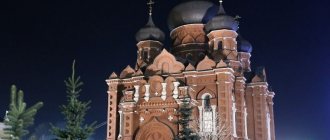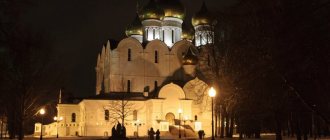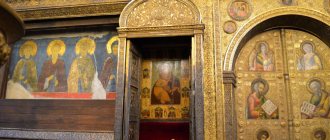The Assumption Cathedral in Smolensk stands on the high Cathedral Hill. The majestic white and turquoise five-domed temple in the Baroque style will not leave anyone indifferent. The French, the Bolsheviks, and the Germans spared him. It seems to hover over the city, protecting it. Some European influence is already felt in the architecture of the temple and the composition of the buildings on Cathedral Hill. Its official name is the Cathedral of the Assumption of the Blessed Virgin Mary.
Assumption Cathedral
Detinets on Cathedral Hill
Smolensk is one of the oldest cities in Rus'. The oldest archaeological layers discovered on Cathedral Hill in the Shkolnaya Street area date back to the 9th century. In the 11th-12th centuries, Detinets was located here - the religious and administrative center of not only the city, but also the entire Smolensk principality. It was surrounded by a wooden wall, a rampart and a moat. In the eastern part of Cathedral Mountain, archaeologists discovered the remains of a stone tower, and to the southwest of the Assumption Cathedral - the foundations of a stone church.
In the 15th-16th centuries, when Smolensk became part of the Grand Duchy of Lithuania, Detinets turned into a religious center, losing its administrative functions. Although outwardly it still gave the impression of a fortress. That is why there is no Kremlin as such in Smolensk.
Assumption Cathedral from Shkolnaya Street
Today's life of the temple
Nowadays, parishioners actively visit the holy place. Archpriest Mikhail Gorovoy fills the Assumption Cathedral of Smolensk with holy words. Divine liturgies and veneration of the icon are performed. Many political figures of the city are present at significant events.
Liturgical chants are being performed. The clear voices are raised to the dome of the cathedral by the cathedral's Bishop's Choir, a children's singing group educated by the Orthodox gymnasium. Also here, compositions are performed by a combined choir, which is trained by the city’s theological seminary and theological school. Divine services are broadcast on television in real time on the main channels of Smolensk.
The church has been automated and made convenient for parishioners; it is being taken care of and improved. So, when you come to the square near the cathedral or the Dnieper embankment, you can watch the service shown on the big screen. But you can feel the special atmosphere of the temple only when you visit it.
The first Assumption Cathedral in Smolensk and its death
The first Assumption Cathedral in Smolensk was founded in 1101 by Prince Vladimir Monomakh, who was for some time the Prince of Smolensk (1073-1078), and then the Prince of Chernigov, Pereyaslavl and, finally, Kyiv. Perhaps the temple was built in the image of the Spassky Cathedral in Chernigov. The Ipatiev Chronicle reads:
...that same summer Vladimir founded a church in Smolensk, the Holy Theotokos stone episcopate.
It was a large city cathedral, the first stone church in Smolensk. In 1150 it was consecrated. In subsequent years, it retained its original features. But he was not destined to survive the Time of Troubles.
In September 1609, the Polish army led by King Sigismund III besieged Smolensk. The siege continued for 20 long months. Despite the fact that scurvy and dysentery began among the city’s defenders, the city successfully defended itself. But the traitor Andrei Dedeshin showed the Poles a weak point - the eastern wall of the Smolensk fortress, built in extreme haste in the wet autumn of 1602. The enemy, concentrating all his forces in that area, broke into the city on June 3, 1611.
Assumption Cathedral in Smolensk
The defenders of the city hid in the Assumption Cathedral. There are two versions about the reasons for the further tragedy. According to one of them, the Smolensk residents themselves blew up the temple, preferring death to shameful captivity and torture. According to another, gunpowder warehouses that were located near the cathedral in the thickness of Cathedral Mountain exploded. Be that as it may, a terrible explosion destroyed the entire top of the cathedral. The townspeople were buried under piles of stone. The Poles finished off the survivors.
However, the invaders did not destroy the cathedral. They covered it with planks and built a church in it. The bishop's house was built nearby. Engravings by V. Gondius, made in 1634-1635, have been preserved, from which one can roughly guess what the Assumption Cathedral in Smolensk looked like at that time. Even in such a dilapidated state, the cathedral made a strong impression: Polish sources call it “huge” and “beautiful”
Assumption Cathedral. From an engraving by V. Gondius
History of the cathedral
After construction in 1101, the temple stood for about 5 centuries. During the war with the Poles in 1611, gunpowder and ammunition were stored in the warehouses of the shrine. The Poles, who broke into the walls of the shrine, blew up the cathedral and built a church on the ruins. Smolensk was liberated only in 1677. After which new construction of the temple began. The shrine was finally completed only in 1740.
The church survived the fire of 1812. During the Great Patriotic War, even the Germans did not touch it. Soviet soldiers were forbidden to use the shrine even as a reference point for aiming weapons. Thus, the cathedral managed to survive despite any wars.
Construction of the new Assumption Cathedral
After Smolensk became Russian again, attempts were made to restore the ancient temple. However, they were unsuccessful - repairing the dilapidated building was considered impossible. In 1674-1675 the cathedral was dismantled. On November 30, 1676, Tsar Alexei Mikhailovich sent Smolensk Archbishop Simeon a plan for a new cathedral, which was to be erected on the site of the previous one. Master Alexey Korolkov arrived from Moscow. For construction, 2 thousand silver rubles and 399 pounds of iron were allocated from the treasury.
The ceremonial laying of the new Assumption Cathedral in Smolensk took place on August 2, 1677. Construction proceeded quickly, and after 1.5 years the walls rose to the level of the windows. For his zeal, the tsar even elevated Archbishop Simeon to the rank of metropolitan and granted him six horses. However, in 1677 work was suspended. The reason was that due to a lack of materials, Korolkov did not build a wall behind the iconostasis. The iconostasis was not connected to the main walls of the cathedral and moved away from them along the entire height. A decree was passed to stop construction work.
Construction resumed only in 1712 under Dorofei. The altar was reduced in length by 3 fathoms, which distorted its proportions.
Architect Schedel: father or son?
In 1728, Archbishop Gideon decided to continue construction of the cathedral. The architect is believed to have been appointed Anton Ivanovich Schedel, the son of the Russian architect of German origin Johann Gottfried Schedel (circa 1680-1752). But here lies a mystery. The version that the new cathedral was built by Anton Ivanovich Shedel was put forward by S.D. Shiryaev*.
*Sergei Dmitrievich Shiryaev (1898-1961) - historian and museum figure. One of the developers of the plan for the Museum of Old Smolensk. In 1922, he took a direct part in the seizure of valuables from the Smolensk Assumption Cathedral. Since October 1923 - director of the Museum of Arts and Antiquities. Author of “Etudes on the history of architecture of Smolensk and the Belarusian Smolensk region” (Smolensk, 1924).
Window of the Assumption Cathedral
He's writing:
The spirit of Western Russian Baroque, which is found in the architecture of the Assumption Cathedral, was probably created under the influence of those artistic impressions that Schedel the son could receive in the same Smolensk. It is characteristic to note the same tendency towards a Western Russian art understanding of Baroque architecture in Schedel the Father... We would hardly still have the right to associate the completion of the Assumption Cathedral with the name of Schedel the Son if we could not refer to the architecture of the cathedral, which definitely speaks of a great master , and most importantly, to some of its techniques, typical of the buildings of Schedel the father, with whom Schedel the son could quite naturally be spiritually connected... This technique of a two-tiered cornice, generally characteristic of the Baroque, is typical of Schedel the father... The upper windows are interpreted in the form of round “oeil de boeuf”, also found in Schedel the Father at the gates of the Oranienbaum Palace...
But there is a nuance here. Sources do not report that Johann Gottfried Schedel had a son, they only talk about a daughter. Perhaps Johann Gottfried, who replaced the dissonant name of Ivan Ivanovich, given to him in Russia, with Anton Ivanovich, became the creator of the majestic temple.
Southern gate of the Assumption Cathedral
It is much more likely that the Smolensk Bishop Gideon Vishnevsky, who received his initial education at the Kyiv Theological Academy and subsequently wrote teachers from there for the theological seminary he founded in Smolensk, turned not to an imaginary son at all, but to Gottfried Johann Schedel himself, who was working at that time in Kyiv. And the famous architect could well have made a project for completing the construction of a huge stone box that had stood on the Cathedral Hill of Smolensk since 1679.
The fact that such a project existed is known from the text of the contract with contractors from the Roslavl district “to complete the construction of the cathedral stone church according to the outline given by the architect,” quoted by the same Shiryaev. At the same time, Shiryaev draws attention to the fact that the construction of the cathedral was entrusted to insufficiently experienced “masonry contractors” and, it seems, was sometimes carried out in the absence of the architect, who “in the case of the completion of the Assumption Cathedral is mentioned only once in 1735.” Let us recall that in 1735 Gottfried Schedel completed the reconstruction of the building of the Theological Academy, and already in the next year, 1736, he began to carry out a large and important order - the construction of the Lavra bell tower. — V.M. Anikeev: Shrines and ascetics of Smolensk. Smolensk, 2009. Pp. 48-51.
So, perhaps it was the famous Johann Gottfried Schedel, who built the Menshikov palaces in St. Petersburg and Oranienbaum (1713-1727); Menshikov's house in Kronstadt (together with I.F. Braunstein), the Favorite palace in Strelna (1716), the house church of the Resurrection of Christ at the Vasileostrovsky palace, which created the ensemble of the Kiev Pechersk Lavra - the bell tower, galleries in the Near and Far caves, keys with cells and other famous buildings, is the author of the majestic Assumption Cathedral of Smolensk.
The newly built temple was crowned with 7 domes. On August 13, 1740, the Assumption Cathedral in Smolensk was consecrated. But soon after this, dangerous cracks appeared in the vaults and domes. As a result, it was decided to replace the plank roof with a tin one. By 1760, the large stone dome had collapsed completely.
At the request of His Grace Parthenius, who headed the Smolensk See at that time, the highest permission was given to remodel the upper vaults. With 11,900 rubles donated by Empress Catherine II and 45 thousand rubles in donations collected through the efforts of Parthenius, it was possible to overhaul the cathedral. According to the design of the architect Pyotr Ivanovich Obukhov (around 1735 - after 1768), the domes of the Assumption Cathedral were rebuilt. The large stone dome was converted into a wooden one, and instead of 7 domes, a traditional five-domed structure was made. To strengthen the upper vaults, iron ties were stretched.
Domes of the Assumption Cathedral
In 1772, the construction of the Assumption Cathedral was completed. Since then, no significant changes have been made to the appearance of the cathedral; only in 1890 a glass porch was added to the western façade.
Western facade of the Assumption Cathedral
Memorial inscription on the wall of the Assumption Cathedral
Incredibly, the Assumption Cathedral in Smolensk survived the Patriotic War of 1812, the turbulent post-revolutionary years, and the Great Patriotic War. By personal order of Napoleon, enchanted by the beauty of the cathedral, a guard was even assigned to it. In the post-revolutionary years, the cathedral for some time housed a museum of atheism, which made it possible to preserve all the valuables. In 1941, when the Nazis captured Smolensk, the commander of the German tank group, General Guderian, ordered the protection of the cathedral. Soviet artillerymen were forbidden to use the cathedral as a reference point for aiming their guns.
Destroyed buildings and the surviving Assumption Cathedral
Assumption Cathedral
Panorama of church buildings of the Assumption Cathedral
Creation of the final version of the cathedral
The master’s new creation, a temple made in the Baroque style and crowned with seven domes, amazed with its beauty. In August 1740 it was consecrated. But in pursuit of external perfection, the architect, apparently, made a number of engineering miscalculations, as a result of which, after twenty years, the central dome and the western dome adjacent to it collapsed.
The Russian architect Pyotr Ivanovich Obukhov, who was invited for this purpose in 1768, had to correct the mistakes of his predecessor. He replaced the previous central dome, made of stone, with a lighter wooden one, and replaced the seven domes with a five-domed one, more traditional for Russian temple architecture. He also introduced a number of other innovations that made it possible to give the cathedral proper strength. The work was completed in 1772, and since then the Assumption Cathedral in Smolensk, the photo of which is presented in the article, has remained unchanged.
Interior decoration and shrines of the Assumption Cathedral
The main altar of the Assumption Cathedral was consecrated in the name of the Dormition of the Blessed Virgin Mary, the chapel - in the name of the Smolensk Icon of the Mother of God Hodegetria. The area inside the cathedral is huge - more than 2000 square meters. meters, which is almost twice as large as the Assumption Cathedral in the Moscow Kremlin. Four columns divide the cathedral into 3 naves and carry vaults. The height of the walls of the quadrangle reaches 29.7 meters. The choirs are located at an altitude of 18.65 meters.
The five-tiered baroque iconostasis of the cathedral was made in 1730-1740 by the Ukrainian carver S. Trusitsky with assistants P. Durnitsky, F. Olitsky and S. Yakovlev. They probably also painted the icons.
Interior decoration of the Assumption Cathedral in Smolensk. Source: Smolensk People's Newspaper, https://smolnarod.ru
The main shrine was kept in the Assumption Cathedral - the prototype of the Smolensk Icon of the Mother of God Hodegetria . However, after the occupation of Smolensk during the Great Patriotic War, it disappeared forever. Now the cathedral houses an icon from the early 17th century, transported from the Church of the Smolensk Icon of the Mother of God Hodegetria, located above the Dnieper Gate of the Smolensk Fortress.
The main attraction of the Smolensk Cathedral is St. the miraculous icon of the Mother of God Hodegetria, reverently revered not only by the Smolensk province, but also by all of Orthodox Russia. It was written, according to Nicephorus Callistus, by the evangelist Luke at the request of the ruler of Syria, Theophilus; therefore it is also called first-written.
According to Demetrius of Rostov, this icon was subsequently transferred to Jerusalem, and from there to Constantinople, to the Blachernae Church; this was in the 5th century. Here the icon provided help and healing to many believers. After the healing of two blind men before the icon, brought by the Mother of God to the Blachernae Church, to Her image, believers gave her the name Hodegetria, that is, Guide. In 1046, the Greek emperor Constantine Monomakh, marrying his daughter Anna to one of Yaroslav’s sons, Vsevolod, blessed her with this icon. Princess Anna kept the icon in Chernigov until her death, and before her death she blessed her son Vladimir, the appanage prince of Smolensk, with it, as a result of which the icon was transferred to Smolensk and placed in the newly built cathedral in 1103.
The board on which the icon is written is very heavy and has become so blackened over time that it is difficult to determine what kind of wood it is made of; it is 1 arsh long. 2 tops, 14 tops wide. During the Tatar invasion of the Smolensk region, the Mother of God called upon St. The warrior Mercury saved the city, and in memory of their deliverance, the Smolensk people established a celebration on November 24.
At the beginning of the fifteenth century. Smolensk Prince Yuri Svyatoslavich (Yurga) went to Moscow with the Hodegetria icon to ask for the help of the Grand Duke and, when he learned about the conquest of Smolensk, he left it in Moscow. Only 50 years later, in 1455, led. Prince Vasily Vasilyevich, at the request of the Smolensk people, returned St. icon. During the siege of Smolensk by Sigismund, St. The icon was sent to Moscow in advance, and after Moscow was occupied by the Poles, to Yaroslavl. Here it remained until the final annexation of Smolensk to the Moscow state by Tsar Alexei Mikhailovich. 1812 On August 6, the day of the assault, the icon was taken out of the cathedral and sent to Moscow, and then to Yaroslavl, from where it was returned on December 25. — “Address-calendar of the Smolensk diocese with historical and church-practical instructions”, Smolensk. Steam tipo-lit. Ya. N. Podzemsky, 1897; cit. from the site sobory.ru
Another shrine of the Assumption Cathedral is the sandals of St. Mercury of Smolensk . Mercury, a foreigner by origin, was praying before the icon of the Mother of God when he heard the command to attack Batu’s camp at night, whose troops approached Smolensk. He managed to almost fulfill his plan and kill many Mongols and their leader-batyr. The next morning, the frightened Mongols retreated from the walls of Smolensk. Mercury, who died in a fight with them, was canonized.
Another shrine of the Assumption Cathedral is the “Entombment” shroud , which is located in the left support column. According to the inscription embroidered on it, it was created in 1561 in the workshop of Princess Euphrosyne Staritskaya, the aunt of Ivan the Terrible. Initially, the shroud was kept in the Assumption Cathedral of the Moscow Kremlin, from where it was stolen by the French in 1812. The Smolensk partisans managed to recapture it, for which it was granted to the Assumption Cathedral in Smolensk. Two more shrouds from Staritskaya’s workshop are kept in the Trinity-Sergius Lavra (1561) and in the Russian Museum (1560).
Window in the altar part of the Assumption Cathedral
Western facade of the Assumption Cathedral
The miraculous icon of Hodegetria
There are two icons of the Mother of God Hodegetria in Smolensk, one is in the cathedral, the other in the Orthodox gymnasium.
Legend says that the icon located in the cathedral was painted by the Evangelist Luke. It was originally located in the Antioch Church, then it ends up in Constantinople in the Blachernae Temple.
When Monomakh gives his daughter to the Chernigov prince, he blesses her with this icon. Later, after the construction of the temple on Cathedral Hill, Monomakh brings the icon from Chernigov and subsequently it acts as the main shrine of the cathedral.
Around 1399, the icon ended up in Moscow and returned to the temple only in 1456. Until 1941, the icon did not leave the walls of the temple, but that year it disappeared without a trace.
Now in its place stands the icon of Our Lady Odigria, which was painted for the gate church. It has an oval ending. Size 243 x 130 cm. She acquired the precious frame only in 1954.
Cathedral bell tower
In 1766-1772, a bell tower was built at the northwestern corner of the Assumption Cathedral. Parts of an earlier bell tower from the 17th century were included in its lower tier. The lower tier is decorated with 24 columns of the Tuscan order. The dome on a small drum is crowned with a helmet-shaped roof. In the eastern part there is an extension with a clock made in 1795 by the Smolensk master V. Sokolov. Next to the bell tower there is a bell from 1636, as is clear from the inscription on it.
Cathedral bell tower
Cathedral bell tower
Bell 1636
History of the Smolensk Icon of the Mother of God
Hodegetria (Pointing the way), Guide - one of the most common types of images of the Mother of God with the Child. The Child-Christ sits in the arms of the Mother of God, with his right hand he blesses, and with his left he holds a scroll, less often a book, which corresponds to the iconographic type of Christ Pantocrator (Almighty). As a rule, the Mother of God is represented in a half-length image, but abbreviated shoulder-length versions (Kazanskaya) or full-length images are also known.
The difference from the rather close type of Eleusa is the mutual relationship of Mother and Son: the icon no longer expresses boundless love, here the center of the composition is Christ, facing the person ahead (the viewer), while the Mother of God, also depicted frontally (or with a slight tilt of the head), points her hand at the Baby .
From a dogmatic point of view, the main meaning of this image is the appearance into the world of the Heavenly King and Judge and the worship of the royal Infant.
According to legend, the very first Hodegetria was performed by the evangelist Luke, brought from the holy land by Eudokia, the wife of Emperor Theodosius, around the middle of the 5th century, and then placed in the Blachernae temple (according to other sources - in the temple of the Odigon monastery, which is why, according to one version, the name comes from). This type of Mother of God icons became unusually widespread throughout the Christian world, and especially in Byzantium and Russia.
Cathedral Mountain Ensemble
In the second half of the 17th century, construction of other church buildings began on Cathedral Hill, which now form an integral ensemble. A bell tower, the Church of John the Baptist (1703), the Epiphany Cathedral, the Bishop's House (now the Smolensk Interdiocesan Orthodox Theological School), a consistory, and a grain building were built. A stone wall with three gates was built around them. In addition, a wall was built between the Bishop's House and the Assumption Cathedral.
Cathedral Mountain Ensemble
On the territory near the Assumption Cathedral
Epiphany Cathedral
The warm Epiphany Gate Cathedral (Cathedral of the Epiphany) was built according to the design of the Smolensk provincial architect M.N. Slepnev in 1785-1787 in the forms of early classicism. Previously, a wooden temple of the same name stood on this site on a high foundation, built in 1708-1713.
Epiphany Gate Cathedral
Gate chapel and buildings of the Smolensk Interdiocesan Orthodox Theological School
On the western side, a grand staircase with a walkway was built for the entrance from Bolshaya Blagoveshchenskaya Street (now Bolshaya Sovetskaya). To the north of it, a building for the services of the bishop's house was erected. In the 19th century, a new consistory building was built in the southeast, and a new fence appeared on the walkway of the Epiphany Cathedral. Later, a new wooden staircase was built below the axis of the main staircase, rebuilt in stone at the beginning of the 20th century.
Staircase to the Assumption Cathedral
Epiphany Gate Cathedral
Assumption Cathedral and Cathedral Bell Tower
The feat of the brave defender of the city
If we talk in more detail about the holy warrior Mercury, at the beginning of the thirteenth century he was the Smolensk governor. The glorious knight defeated the Mongol-Tatar army. The battle took place near the village of Dalgomostya, which could be reached by walking 27 kilometers south from the Smolensk region.
Mercury died the heroic death of a true defender of his native land. When the governor chased the cowardly enemy, they fought in a battle, from which the Tatar emerged victorious. With reverence and awe, the relics of the military leader, canonized after his death, were preserved within the walls of the divine place, which at that time was called the Assumption Monomakh Cathedral.
The 17th century brought more suffering to the city. He defended himself from Polish troops. In the heat of battle, someone stole the relics. At the beginning of the 19th century, a warrior's spear was also stolen from the temple. The looting did not stop there, and in the mid-20th century the helmet also disappeared. And only the sandals are still in their place.
If you believe the legend, the presence of the military armor worn by the martyr Mercury in the city ensures the patronage of the Heavenly Queen over Smolensk and defense from all misfortunes.
Observation deck on Cathedral Hill
To the northeast of the Assumption Cathedral there is an observation deck from where magnificent views of the Smolensk Fortress, the Dnieper, churches and new city blocks open. It's definitely worth a visit here.
Eastern section of the fortress wall
Panorama of the eastern section of the fortress wall of Smolensk
View to the north: fortress walls and the Trans-Dnieper part of Smolensk
Church of the Smolensk Icon of the Mother of God (Dnieper Gate)
Nizhne-Nikolskaya Church
Church of St. George the Victorious and fortress wall
Shrines[edit]
The main shrine of the cathedral is the Smolensk Icon of the Mother of God Hodegetria
. Two cast-iron stairs lead to it, converging on the platform near the icon. The icon is located at the right support pillar of the temple. At the left support pillar there is another shrine - the shroud “Entombment” from the workshops of Euphrosyne Staritskaya (1561). The Kazan Icon of the Mother of God, taken to the left side chapel from the altar after the myrrh-streaming on November 22, 1991. Icon of St. Seraphim of Sarov - became especially revered after the myrrh-streaming on March 14-15, 1994. A large wooden Crucifix on the right side of the temple, its painting is attributed to V. Vasnetsov. The five-tiered iconostasis of the cathedral was made in the 1730-40s. carver S. Trusitsky with assistants P. Durnitsky, F. Olitsky and S. Yakovlev. The icons (later renewed) were probably painted by the same masters.
Information for travelers
- It is best to park your car in the parking lot near the monument to M. Kutuzov, located between Sobornaya Gora and Bolshaya Sovetskaya streets.
- You can also approach the Assumption Cathedral from Shkolnaya Street, but there is no parking there, you will have to turn around and park the car in another parking lot.
- There are many beggars and beggars near the Assumption Cathedral.
- The kiosk next to the Assumption Cathedral sells delicious locally baked bread, be sure to buy it.
- Photography is prohibited in the Assumption Cathedral.
- There are skirts and scarves for women, but during the service there may not be enough for everyone.
Assumption Cathedral at the end of Bolshaya Sovetskaya Street
Address: 214000, Smolensk, Cathedral Courtyard, 5
© Website “On the Roads of the Middle Way”, 2009-2021. Copying and reprinting of any materials and photographs from the site anashina.com in electronic publications and printed publications is prohibited.
Reconstruction and restoration
Then, over the course of the 17th and 18th centuries, residents were engaged in the restoration of the temple. They threw all their efforts into reconstructing the Assumption Cathedral. Smolensk spent a lot of money so as not to lose this unique architectural monument.
During the restoration, critical mistakes were made, which resulted in multiple collapses of the domes. But gross violations were corrected, the perpetrators were punished, so the Holy Assumption Cathedral (Smolensk) was nevertheless reborn from the ruins. With repeated restoration, the building has changed somewhat. Today we see it in a different guise compared to what the temple was like in the 12th century. But he has not lost his majesty, impressiveness and beauty. They say that Napoleon, when he first saw the Smolensk Cathedral, respectfully took off his cocked hat.











